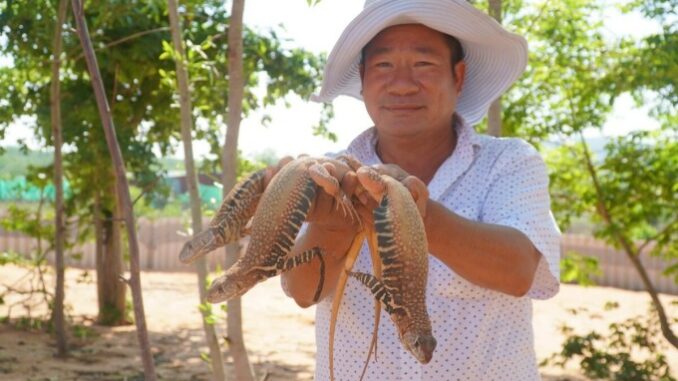
BINH THUAN – After a few years of stagnation due to the inability to find output, people in Thien Nghiep commune (Phan Thiet city) are restoring the farming of Leiolepis on sandy soil to increase their income.
At midday, Mr. Le Minh Tam, 49 years old, in Thien Hoa village, Thien Nghiep commune, wore a cap to visit a barn located in the middle of an open field. The barn area is more than 2,000 m2 wide and is covered with old cement corrugated iron sheets. Hearing the sound of people, hundreds of Leiolepis sunbathing on the sand immediately ducked into the cave and ran away. “Leiolepis has the characteristic of being very shy, whenever it hears a sound, it immediately hides in the cave,” said Mr. Tam.

Leiolepisis a species that lives naturally on the sandy hills along the coast of Binh Thuan, especially in the Thien Nghiep land adjacent to Mui Ne. Around 2006, the demand for tourism increased, and local farmers experimented with semi-wild-type Leiolepiss with success. After that, raising dong became a popular profession because of low investment costs, less labor, but better income than growing crops and melons for seeds.
Mr. Tam said that more than a decade ago, his family used to raise Leiolepis to increase their income. In 2020, when Covid-19 appeared, Leiolepis began to drop in price, at one point no one bought because restaurants in Phan Thiet had to close to fight the epidemic. He, like many farmers in Thien Nghiep commune, quit the job. They only raise a small amount to keep seeds and make food for the family.
Since last summer, Binh Thuan tourism began to recover after the pandemic, and domestic and international tourists returned to Mui Ne – Phan Thiet more crowded. Tourist areas and restaurants are open to welcome guests, so the demand for local specialties increases again, including dishes made from Leiolepis.

According to Mr. Tam, the pork belly is simple to cook, but very delicious. Common dishes are often prepared by local people from Leiolepis such as: grilled, dried coconut, mixed salad with forest leaves; Dong cooked with tamarind leaves, construction leaves, vegetables or chopped, scoop out rice paper, pour pancakes.
Recently, many eateries and restaurants in Mui Ne – Phan Thiet have gone to find sources of food to sell to tourists, but the goods are scarce because many households have given up their jobs or only farmed in moderation. Realizing that the consumer market is strong but the supply is short, Mr. Tam and some other households decided to raise the dongsaeng again. “I have released more than 600 breeders, hopefully in the next few months, when the first litter is released, the family will have more income,” said Mr. Tam.
Nearby, Mr. Nguyen Van Hoang also raised 700 Leiolepis in a 2,500-square-meter barn on white sandy soil. This farmer said that as long as the current price is kept stable at 500-600 thousand VND/kg, ($1=24,000 VND)the Leiolepis will bring high economic benefits. Because the investment capital for this type of semi-wild livestock is very low. The cost of the barn is low, only a few million to buy old corrugated iron. Feeding Leiolepis is also simple, just give them a few bunches of vegetables in the morning.
“They dig their own burrows, drink dew, find more food (insects, plants) in the wild, with very little care,” said Mr. Hoang, adding that he raised them alone, but could earn tens of thousands of dollars. million dongs.

Leiolepiss are finger-like, after 6-8 months, they mature, start to reproduce and can be harvested. On average, each fish is about 200g (5 children get 1 kg). If raised for more than a year, each animal weighs about 250-300 g. According to Mr. Hoang, it is about a month before the Leiolepiswill be released, but a local company has ordered the whole product to be consumed, so farmers are assured. Therefore, in the near future, he will expand the barn area to double.
Mr. Tran Ngoc Han, Chairman of Thien Nghiep Commune Farmers’ Association, said that at present, the whole commune has about 20 farming households that are restoring the farming of sand dunes with a barn size of 1,000 m2 or more per family. This is a good sign after many years of farming this advantageous specialty in the locality, which has been halted due to uncertain output.
According to Mr. Han, through the field survey, the commune farmers’ association found that tourism activities in the area of Mui Ne – Ham Tien (next to Thien Nghiep commune) are recovering. The demand of diners for this specialty is increasing gradually, so farmers do not have to worry about the output. “Currently, many restaurants come to Thien Nghiep to buy Leiolepis for 800,000 to one million dong a kilo, but there are still not enough sources of goods,” said Mr. Han.
( According to vnexpress )
